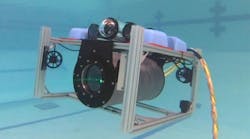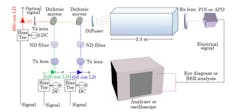Conquering Underwater-Communication Challenges with Electro-optics, Radar
The proliferation of autonomous underwater vehicles is adding to the urgency of developing reliable techniques for robust, reliable links, both between these vehicles as well as to them from above the surface. While the U.S. Navy and others have (in the past) used extremely low frequency (ELF) carriers at around 100 Hz (yes, that’s hertz) combined with antennas spanning several square miles and multi-megawatt power amplifiers (see references) to achieve single-digit bit rates, that approach is clearly not practical here.
In a word, underwater communication is difficult challenge, due to the inherent physics of the situation and the electromagnetic characteristics of water, especially salt water. Still, significant research efforts have been directed toward alternative solutions made feasible by advances in electro-optics, millimeter-wave radar, and signal-processing algorithms. Three examples show the progress thus far:
Laser-Diode Array
Researchers at Fudan University, (Shanghai, China) and University of Toronto (Ontario, Canada) used a combined red/green/blue (RGB) laser-diode array to achieve transmission rates up to 3.4 Gb/s at up to 2.3 m with a single laser-diode triplet, and an even-faster aggregate 9.7 Gb/s using an on-off keying (OOK) modulation and wavelength-division multiplexing (WDM).
They combined underwater solid-state lighting (SSL) and WDM to create an underwater, wireless optical-communication (UWOC) system based on a combination of standard laser diodes with GaN-based blue (450 nm) and green (520 nm) devices, plus a red AlGaInP (660 nm) diode, all stabilized to around 25°C using a Peltier thermoelectric cooler. The overall design applied a combination of mirrors, lenses, and optical filters, with the received laser signal captured by a PIN or avalanche photodiode (Fig. 1). Details are presented in their paper “Laser-based white-light source for high-speed underwater wireless optical communication and high-efficiency underwater solid-state lighting.”
1. Setup of the RGB LED-based white-light system uses underwater solid-state lighting and wavelength-division multiplexing for an underwater wireless optical communication. (Source: Fudan University)
Narrow-Beam Laser
At MIT’s Lincoln Laboratory, researchers are trying to solve a similar underwater-link problem by applying the narrow-beam laser technology used in the Lunar Laser Communication Demonstration (LLCD) project, where a pulsed laser beam transmitted data from a satellite orbiting the moon to Earth at a record-breaking download speed of 622 Mb/s. In their project, summarized here, they were able to acquire and track narrow optical beams between two mobile vehicles.
As noted by researcher Nicolas Hardy, "We implemented an acquisition scanning function that is used to quickly translate the beam over the uncertain region so that the companion terminal is able to detect the beam and actively lock on to keep it centered on the lasercom terminal’s acquisition and communications detector." As a result, two underwater vehicles were able to locate, track, and effectively establish a link, despite the independent movement of each vehicle underwater (Fig. 2).
2. The researchers performed tests with the undersea optical communications system at a local pool near Lincoln Laboratory, showing that two underwater vehicles could efficiently search and locate each other. (Source: MIT)
Their approach used wide-bandwidth signaling features in the communications waveform to determine the relative position between the two vehicles with high precision, once the two terminals have locked onto each other and are communicating. After detecting the remote terminal’s beacon, the local terminal can lock on and pull into coarse-track mode in less than one second, with the relative bearing and range known to within a few centimeters.
Translational Acoustic RF
Finally, MIT Media Lab researchers are working on the challenge of communicating from underwater to an overhead airborne receiver. Their translational acoustic-RF communication (TARF) system enables underwater nodes to directly communicate with airborne nodes by transmitting standard acoustic signals in a sonar-like scenario. The approach exploits the fact that that underwater acoustic signals travel as pressure waves, and that these waves cause incredibly minute displacements at the water’s surface when they reach and impinge on the water-air boundary.
The system uses a specialized airborne radar that extracts and decodes these surface displacements, which are on the order of few microns. Then, via advanced signal-processing algorithms, these displacements are quantified even though they’re buried in random surface-noise reflections as well as shifts in baseline height between the surface and aircraft (Fig. 3).
3. Surface vibrations from the underwater source translate into phase modulation, and a radar-based receiver is used to capture the phase of the wireless reflection changes caused by minute surface vibrations. (Source: MIT)
Their very readable paper “Networking across Boundaries: Enabling Wireless Communication through the Water-Air Interface” provides full details of an approach that seems to be “magic,” but does work. The acoustic-source speaker operates at 150 Hz, driven by orthogonal frequency-division multiplexing (OFDM) encoding. For the airborne radar, they used a millimeter-wave frequency-modulated carrier wave (FMCW) receiver to capture the reflections from the water surface. Finally, using knowledge of the water “channel” characteristics (to the extent that it’s possible), they implemented highly advanced algorithms to decode the returns.
In this one-way channel, there’s obviously no possibility of feedback between source and receiver, which constrained their choices for some of the modulation- and channel-specific decisions they made. Nonetheless, they were able to demonstrate a link operating at up to 400 bits/s despite surface waves with amplitudes up to 16 cm (peak-to-peak), which is 100,000 times larger than the surface perturbations induced by their underwater acoustic transmitter that they were measuring.
References
“Appendix B: Submarine Communications Shore Infrastructure”




